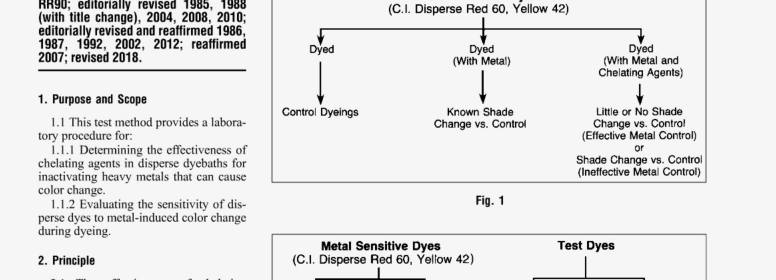Color Change of Disperse Dyes Caused by Metals

AATCC 161-2018 pdf free.Color Change of Disperse Dyes Caused by Metals, with and without Chelating Agent.
1.1 This test method provides a laboratory procedure for:
1.1.1Dctcrmining the effectiveness of chelating agents in disperse dycbaths for nactivating heavy metals that can cause color change.
1.2 Evaluating the sensitivity of disperse dyes to metal-induced color change during dyeing.
2. Principle
2.1 The effectiveness of chelating agents in sequestering metals in a dye- bath, thereby preventing metal-induced color change, is determined by the protocol in Fig. I.
2.2 Metal sensitivity of disperse dyes is determined by comparing control dyes and test dyes by the protocol shown in Fig. 2.
3. Terminology
3.1 chelating agent. n.—in tertile chemistry, a chemical capable of inactivating metal ions by formation of a water-soluble complex. SYN: sequestering agent.
3.2 color change, n.—a change in color of any kind whether in lightness. hue or chroma. or any combination of these, discernible by comparing the test specimen with a corresponding untested specimen.
3.3 grade. n.—thc number assigned to a test specimen resulting from comparison to a scale.
3.4 Gray Scale, n.—a scale consisting of pairs of standard gray chips. the pairs representing progressive differences in color or contrast corresponding to numerical colorfastness grades.
NOTE: Gray Scale grades are expressed as half-steps in decimal fonn (e.g.. 1 or I .5). Dashed form is also acceptable (e.g.. I or 1-2).
3.5 metal sensitivity, n.—thc propensity of a dye to produce an abnormal color on a textile material when in the presence of certain metal ions.
These safety precautions are for information purposes only. The precautions arc ancillary to the testing procedures and arc not intended to be all inclusive. It is the users responsibility to use safe and proper techniques in handling materials in this test method. Manufacturers MUST be consulted for specific details such as material safety data sheets and other manufacturer’s recommendations. All ()SHA standards and rules must also be consulted and followed.
4.1 (lood laboratory practices should be followed. Wear safety glasses in laboratory areas.
4.2 Pressurized dyeing equipment is required for some dyeing. Trained personnel should exercise care and follow the equipment manufacturer’s instructions for use and safety precautions.
4.3 All chemicals should be handled with care.
4.4 In preparing, dispensing and handung acetic acid and phosphoric acid. use chemical goggles or face shield. imperviotis gloves and an impervious apron. Concentrated acids should be handled only in an adequately ventilated laboratory hood. CAUTION: Always add acid to water.
4.5 Carriers vary in toxicity depending on type. Read vendors technical data, SDS andior product label for contents and/or OSIIA hazard classification.
4.6 An eyewashJsafety shower should be located nearby and a high efficiency particulate respirator with a full facepiece should be readily availablc for emergency use.AATCC 161 pdf free download.